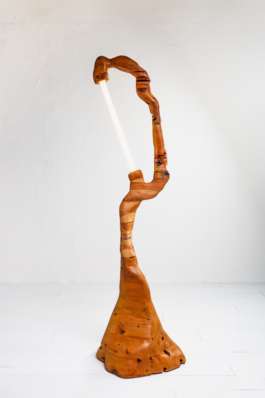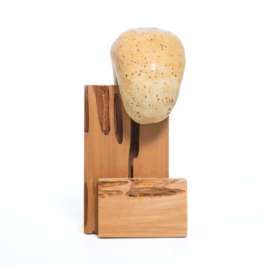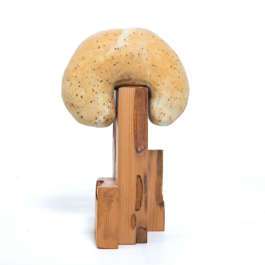



Coco Ree Lemery, Cypress Lighting Collection, 2023 © Studio Kloak
COLLECTIBLE In-Depth
March 2024
This series, COLLECTIBLE In-Depth, unveils the backstage of contemporary creation. Tackling various topics from personal designer processes to the position of collectible design on the global design market, COLLECTIBLE In-Depth offers different views to suit all tastes. Today we talk to Coco Ree Lemery.
COLLECTIBLE: How do you see the relationship between late 20th century design and contemporary design? How does one feed one another?
Coco Ree Lemery: The global landscape of design underwent a profound transformation in the aftermath of World War II, deeply influenced by the tragic imagery of the era. Emerging from this period, we witnessed a collective simplification of the visual realm, epitomized by movements such as the Swiss style of graphic design with its iconic typeface Helvetica, mark Rothko’s transcendent fields of color, and the rise of architectural modernism.
Today, we find ourselves in a similar yet distinctly modern epoch, where the imagery of war has been obscured by an inundation of excessively “beautiful” visuals and the omnipresence of short-form videos, as well as the emergence of ai-generated renderings capable of conjuring utopian landscapes with remarkable realism. This contemporary landscape has catalyzed a new paradigm in design—a paradigm marked by a rejection of mass manufacturing and the pursuit of flawless forms.
In this visual saturation, there’s a shift towards embracing bold textures and natural materials, imbuing designs with an authentic, tactile quality that resonates deeply with the human experience. Imperfection is no longer shunned; rather, it is celebrated as a tangible expression of authenticity and character.
We now find ourselves at the dawn of a new era in design, one characterized by a profound appreciation for the imperfect, the tactile, and the real—a departure from the sterile perfection of mass manufacturing towards a visual world that is vibrant, dynamic, and undeniably human.
C: How does the digital sphere impact your work? What is your relationship to 3d, ai etc?
CRL: This semester, I have the privilege of teaching a class that delves into the fascinating intersection of ai and design. One of the most captivating projects my students are engaged in involves harnessing the power of ai to craft traditional craft tutorials, guiding users in the creation of functional objects by hand. What’s particularly compelling is the beautiful parallel between the iterative nature of craft and ai—both evolving in tandem with the progress of humankind.
Throughout the course, I’ve observed a striking correlation between student success and their willingness to embrace experimentation and take charge of the AI tools at their disposal. There’s a common misconception that ai will shoulder the entirety of the creative burden, but in reality, our role as designers is to provide the guiding framework and shape the final form, much akin to the meticulous process of craft making.
I firmly advocate for viewing ai as a tool rather than a crutch. When wielded correctly, it has an unparalleled capacity to amplify our creative capabilities and swiftly materialize abstract concepts into tangible realities. Design education emphasizes the importance of visualizing concepts that exist solely in the realm of imagination. Similarly, design itself encompasses a diverse array of tools—modeling, drafting, drawing—all employed to articulate our design intent. By reframing our perception of ai as a means to streamline communication rather than a surrogate for creative thinking, we open ourselves to a realm of endless possibilities.
C: What do you think collectible design brings compared to other more massively produced pieces?
CRL: Having designed hundreds of mass-produced furniture and home design pieces, I firmly advocate that collectible design necessitates an elevated level of craftsmanship and design from skilled artisans. At its core, collectible design embodies the intrinsic value of human labor, requiring a profound devotion from the creator.
Sustainability also stands as a cornerstone of collectible design. Unlike conventional manufacturing, where industrial glues may be employed for efficiency, collectible design demands elegant and thoughtful approaches that transcend mere utilitarianism. The integration of recycled materials, though labor-intensive, serves as a hallmark of exemplary collectible design. Such materials are meticulously reimagined to breathe new life into luxury items that seamlessly blend beauty with functionality. In essence, collectible design represents a harmonious fusion of artisanal expertise, sustainability, and innovative material recontextualization, elevating each piece into a timeless masterpiece.
C: Can you talk about a new piece / collection that you release for collectible this year?
CRL: At collectible 2024, I’m thrilled to unveil part of the cypress collection—an endeavor years in the making. This new work begins its journey with raw materials sourced from centuries-old demolition waste—a poignant homage to the past and a bold step towards a more sustainable future. Repurposing every element, from lumber to shingles, we breathe new life into these discarded relics, transforming them into exquisite collectible forms.
Central to this collection is the utilization of pecky cypress, a material renowned for its captivating dark pockets and rich history. Materials rescued from centuries-old domestic roofs; each piece not only pays homage to the craftsmanship of bygone eras but also serves as a testament to the enduring beauty of historic architecture.
What sets this work apart is our unwavering commitment to sustainability and technology at every stage of the design process. From the meticulous sourcing of materials to the inclusion of custom-made led lightbulbs, every element is thoughtfully crafted.

Coco Ree Lemery, Cypress Vase #2, 2023 © Studio Kloak

Coco Ree Lemery, Cypress Vase #2, 2023 © Studio Kloak

Coco Ree Lemery, Cypress Vase #2, 2023 © Studio Kloak
COLLECTIBLE In-Depth
March 2024

Coco Ree Lemery, Cypress Lighting Collection, 2023 © Studio Kloak
This series, COLLECTIBLE In-Depth, unveils the backstage of contemporary creation. Tackling various topics from personal designer processes to the position of collectible design on the global design market, COLLECTIBLE In-Depth offers different views to suit all tastes. Today we talk to Coco Ree Lemery.
COLLECTIBLE: How do you see the relationship between late 20th century design and contemporary design? How does one feed one another?
Coco Ree Lemery: The global landscape of design underwent a profound transformation in the aftermath of World War II, deeply influenced by the tragic imagery of the era. Emerging from this period, we witnessed a collective simplification of the visual realm, epitomized by movements such as the Swiss style of graphic design with its iconic typeface Helvetica, mark Rothko’s transcendent fields of color, and the rise of architectural modernism.
Today, we find ourselves in a similar yet distinctly modern epoch, where the imagery of war has been obscured by an inundation of excessively “beautiful” visuals and the omnipresence of short-form videos, as well as the emergence of ai-generated renderings capable of conjuring utopian landscapes with remarkable realism. This contemporary landscape has catalyzed a new paradigm in design—a paradigm marked by a rejection of mass manufacturing and the pursuit of flawless forms.
In this visual saturation, there’s a shift towards embracing bold textures and natural materials, imbuing designs with an authentic, tactile quality that resonates deeply with the human experience. Imperfection is no longer shunned; rather, it is celebrated as a tangible expression of authenticity and character.
We now find ourselves at the dawn of a new era in design, one characterized by a profound appreciation for the imperfect, the tactile, and the real—a departure from the sterile perfection of mass manufacturing towards a visual world that is vibrant, dynamic, and undeniably human.
C: How does the digital sphere impact your work? What is your relationship to 3d, ai etc?
CRL: This semester, I have the privilege of teaching a class that delves into the fascinating intersection of ai and design. One of the most captivating projects my students are engaged in involves harnessing the power of ai to craft traditional craft tutorials, guiding users in the creation of functional objects by hand. What’s particularly compelling is the beautiful parallel between the iterative nature of craft and ai—both evolving in tandem with the progress of humankind.
Throughout the course, I’ve observed a striking correlation between student success and their willingness to embrace experimentation and take charge of the AI tools at their disposal. There’s a common misconception that ai will shoulder the entirety of the creative burden, but in reality, our role as designers is to provide the guiding framework and shape the final form, much akin to the meticulous process of craft making.
I firmly advocate for viewing ai as a tool rather than a crutch. When wielded correctly, it has an unparalleled capacity to amplify our creative capabilities and swiftly materialize abstract concepts into tangible realities. Design education emphasizes the importance of visualizing concepts that exist solely in the realm of imagination. Similarly, design itself encompasses a diverse array of tools—modeling, drafting, drawing—all employed to articulate our design intent. By reframing our perception of ai as a means to streamline communication rather than a surrogate for creative thinking, we open ourselves to a realm of endless possibilities.
C: What do you think collectible design brings compared to other more massively produced pieces?
CRL: Having designed hundreds of mass-produced furniture and home design pieces, I firmly advocate that collectible design necessitates an elevated level of craftsmanship and design from skilled artisans. At its core, collectible design embodies the intrinsic value of human labor, requiring a profound devotion from the creator.
Sustainability also stands as a cornerstone of collectible design. Unlike conventional manufacturing, where industrial glues may be employed for efficiency, collectible design demands elegant and thoughtful approaches that transcend mere utilitarianism. The integration of recycled materials, though labor-intensive, serves as a hallmark of exemplary collectible design. Such materials are meticulously reimagined to breathe new life into luxury items that seamlessly blend beauty with functionality. In essence, collectible design represents a harmonious fusion of artisanal expertise, sustainability, and innovative material recontextualization, elevating each piece into a timeless masterpiece.
C: Can you talk about a new piece / collection that you release for collectible this year?
CRL: At collectible 2024, I’m thrilled to unveil part of the cypress collection—an endeavor years in the making. This new work begins its journey with raw materials sourced from centuries-old demolition waste—a poignant homage to the past and a bold step towards a more sustainable future. Repurposing every element, from lumber to shingles, we breathe new life into these discarded relics, transforming them into exquisite collectible forms.
Central to this collection is the utilization of pecky cypress, a material renowned for its captivating dark pockets and rich history. Materials rescued from centuries-old domestic roofs; each piece not only pays homage to the craftsmanship of bygone eras but also serves as a testament to the enduring beauty of historic architecture.
What sets this work apart is our unwavering commitment to sustainability and technology at every stage of the design process. From the meticulous sourcing of materials to the inclusion of custom-made led lightbulbs, every element is thoughtfully crafted.

Coco Ree Lemery, Cypress Vase #2, 2023 © Studio Kloak

Coco Ree Lemery, Cypress Vase #2, 2023 © Studio Kloak
Contact
info@collectible.design
VIP PORTAL
EXHIBITOR PORTAL
PRIVACY POLICY
© 2025 Collectible
Contact
info@collectible.design
VIP PORTAL
EXHIBITOR PORTAL
PRIVACY POLICY
© 2025 Collectible